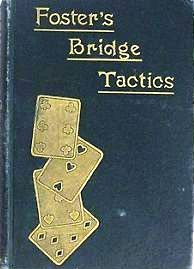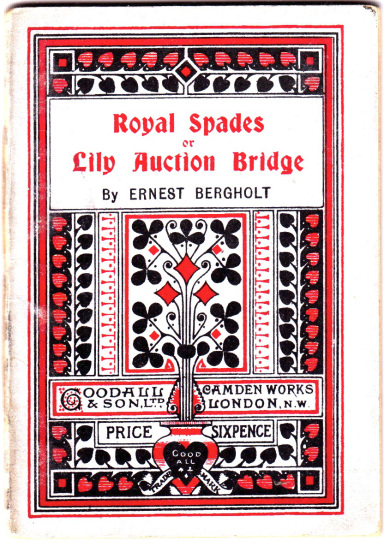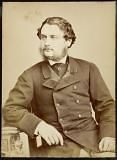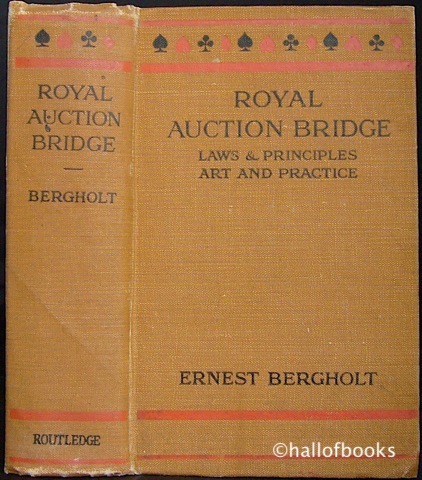 by R. F. Foster. May 1900
by R. F. Foster. May 1900
Robert Frederick Foster (May 31, 1853 – December 25, 1945) of New York City, known as R. F. Foster, was a memory training promoter and the prolific writer of more than 50 nonfiction books. He wrote primarily on the rules of play and methods for successful play of card, dice, and board games. Alan Truscott wrote 20 years after his death that Foster “had been one of the great figures in whist and bridge” for 60 years.
THE most remarkable play I have ever seen or heard of was brought off in the following hand, and the beauty of it was that the play was made without a moment’s hesitation, as if there were nothing else to be done.
Mr. Foster’s article has been submitted to other Bridge experts, who have supplied specimens of what they consider to be the best games of Auction Bridge within their knowledge.
| A | ||
| |
||
| Z | Y | |
| |
|
|
| B | ||
| |
||
| Z | A | Y | B |
| 2 |
3 |
3 |
4 |
| 4 |
DBL | 4 |
DBL |
Z dealt and bid two hearts, A three diamonds,and Y three spades. B went to four clubs, and Z to four hearts, in spite of his partner’s denying that suit. A doubled. Had Z been left to play the hand at hearts, he would have been down for 300, but Y took him out of the double with four spades, which B doubled.
It will readily be seen that if the average player had held Y’s cards, he would have been down for 500 points on the play, as B, who has no diamonds, would lead ace of clubs. As all good players use the down-and-out echo against a trump declaration, B would know by the fall of the two small cards from A and Y that A had the king or no more.
The second club A would trump, and would run off four winning diamonds. Whether B trumps the diamond to give A another ruff on clubs or passes it does not matter, as they must make two trump tricks, or the fourth diamond and a trump. This downs the contract for five tricks ; but instead of that Y won the game, making four odd, or five tricks more than this play shows.
The moment B laid down the ace of clubs, Y realized that he could not have a diamond, or he would never lead away from an ace-queen suit. Y also saw that B, who was a very good player, would immediately read his partner for the king of clubs or no more, and in order to lead B to believe that A held all three of the small clubs, 5, 3, and 2, Y promptly dropped his king on the ace.
The situation now appears to B to be that if he leads the queen of clubs he not only gives Y a ruff, but establishes that best club against himself in the dummy. The best chance seems to be to lead through the denied suit, hearts. B therefore led the small heart, as if he had an honour, hoping to tempt dummy to finesse.
Dummy put up the king, led the ace, and trumped the third round. Then Y led three winning trumps, exhausting A, and marking that player with six diamonds, no clubs, and no hearts ; therefore he cannot hold the jack of trumps, which must be with B. By leading the losing trump he forced B to lead the clubs, and the jack of clubs wins the game.
Instead of losing 500 points, Y wins 122. This shows a difference of 622 points, all of which hinges on the play of one card.
By Ernest Bergholt
One of the people wrote card-game rule-booklets that were published by Charles Goodall & Son was a man named Ernest Bergholt (1856-1925). If the history of whist, bridge, patience games, and pastimes ever had a genius, it may have been Bergholt.
THE following was played with the greatest ingenuity by my lamented friend, the late W. H. Whitfeld:
| A | ||
| |
||
| Z | Y | |
| |
||
| B | ||
| |
||
| Z | A | Y | B |
| 1 |
1 |
1 |
2 |
| Pass | Pass | 2 |
The End |
B led the queen of hearts, Z and A followed, and Y (the declarer) won with the ace. Now, I happen to be in a particularly good position for knowing how this hand would have been played in an ordinary way, because,
when I first published The Principles and Practice of Whist I received from a very high authority on the game the following critical remarks :
What strikes me particularly [about this hand] is that no ordinary bridge-player, playing at the card-table, and knowing nothing about the placing of the unseen cards, would rise to the height of the deductions which you set out ; the play is very pretty, but it is beyond the limits of even a first-class player. If I were playing the hand, I should after clearing the trumps with ace and king (playing the 3 and 8 from dummy) — take out three rounds of clubs, trump the fourth round, put dummy in again with the knave of trumps, and so win eleven tricks and the game. That would be the ordinary way
But Whitfeld, without risking anything, played for and won the small slam. At Trick 3, when B’s queen of trumps fell to his king, he saw that the 10 would necessarily fall from A’s hand. He therefore got rid of dummy’s knave, in order that, if necessary, he might be able to take over the 8 with the 9 in his own hand. It is to be observed that this is no bar to following out my critic’s line of play, because Y can still lead, if he wishes, the 6 of trumps from his own hand, for dummy to win with the 8. In point of fact, he left himself with a double option.
At Trick 4, Y led the knave of clubs, covered by B with the queen, and won by dummy with the king ; A followed suit.
At Trick 5, dummy led the ace of clubs, and A renounced. The declarer at once saw that B would remain with the 9 and 5. He there fore threw the eight from his own hand, so that the run of the suit might not be interrupted when clubs were led again through B up to dummy’s 10. 6.
Now, the full value becomes evident of the " option " in trumps which the declarer had retained. At Trick 6, dummy led the 8 of trumps won by Y’s 9. He then (Tricks 7, 8 9) continued the clubs, and was able to throw away two losing cards on them before A B got in. Result : Y Z won small slam.
Of course the difference in points made by Y’s clever play was not so sensational as in Foster’s hand ; but the judgment and foresight displayed were highly remarkable.
By Yarborough

2nd Earl of Yarborough
Charles Anderson Worsley Anderson-Pelham, 2nd Earl of Yarborough (12 April 1809 – 7 January 1862) was a British nobleman who succeeded to the Earldom of Yarborough in 1846. Lord Yarborough gave his name to a hand of cards dealt in contract bridge that has no card higher than a nine. The British Earl of Yarborough, during the 19th century, would offer a wager of 1,000 pounds to 1 against picking up such a hand at whist.
EVEN after a consultation of records extending over a long series of years, I find it very difficult to fix upon any hand as being the best that I have seen. The following, however, which I saw played by Ernest Bergholt — and which, I understand, he subsequently published — has always struck me as involving some specially subtle and instructive points:
| A | ||
| |
||
| Z | Y | |
| |
||
| B | ||
| |
||
| Z | A | Y | B |
| 1 |
2 |
2 |
3 |
| 3 |
Pass | Pass | DBL |
| Pass | 3NT | The End |
Score : A B, love ; Y Z, 20.
Z dealt and bid one heart, A two clubs, and Y two diamonds. B assisted with three clubs. Z three hearts, which A and Y passed, but B doubled. Z passed. It now appeared to A that three no-trumps ought to be a certainty for game. B had raised in clubs and had doubled hearts, while A himself had command of diamonds. To play for game seemed decidedly better (particularly at a backward score) than trying for penalties, so A bid the three no-trumps, which everyone passed.
It is quite a disputable point whether Y should have started with his own diamonds, or led to his partner’s hearts ; but, as a matter of fact — hoping to find Z with at least the king- he led the queen of diamonds. Dummy’s hand went down ; Z played the king ; and A passed the trick. At Trick 2, Z returned the diamond, and A (not being certain whether Z held a third diamond or not) again held up his ace. Y won, and led a third round, forcing out the ace, while Z threw the 5 of hearts. Note right here that the declarer had to make two discards on the diamonds, and that these discards called for good judgment. It was important to get rid of one of the clubs, for fear of blocking the suit. On the other hand, the declarer did not yet know enough about the clubs to be able to decide whether he would want a third club in dummy (so as to be able to lead through Z) or not. At Trick 2, therefore, he threw the deuce of hearts, and, at Trick 3, the 7 of clubs.
The business of the declarer now was not to give Y any preventable opportunity of getting in to make his long diamonds, and he proceeded to provide for the contingency of Y’s holding four spades to the queen. At Trick 4, he led 9 of spades, Y played the deuce, and B the 4. At Trick 5, A went on with the 3, Y played the 5, and B won with the 10. At Trick 6, B led king of spades, Z discarded 6 of hearts, A played the jack, and Y the 8.
The declarer could now count Y with the lone queen of spades and four diamonds. He had, therefore, only two cards between the hearts and the clubs. At Trick 7, he led dummy’s 10 of clubs, on which Z played the deuce. A figured that if Y held the king of clubs it was most likely lone, and that it would never do to venture any finesse, so he put up the ace, and the king dropped!
Observe, now, that the declarer can place every remaining card of the hand. Z is known to hold jack and 5 of clubs, and the play becomes a peculiarly pretty proposition. Dummy must be put in (Trick 8) with the ace of hearts, and B must then lead another club through Z*s knave. If (i.) Z should decline to cover, A will play a small club, leaving the suit established, and dummy with a club to lead. But if (ii.) Z covers with the knave, A will win with the Queen, and next (Trick 10) lead out his ace of spades, on which dummy will discard his last (blocking) club.
It was case (ii.) that materialized ; anyway, Z was helpless and A B won eleven tricks — game, with two tricks to spare.
Esta entrada también está disponible en: Spanish

